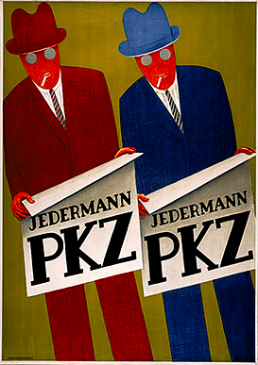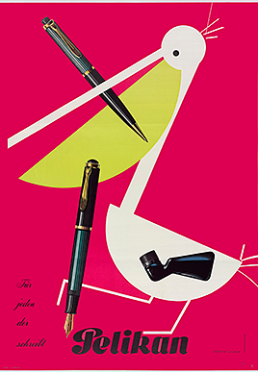The Basel School is synonymous with outstanding Object Poster designs from the period between 1920 and 1950 that advertise products with a minimal combination of image and text conveying a clear message.
The Basel School displays the following characteristic features:
- A single, oversized, simplified and yet realistic subject
- A brief slogan, often amounting to no more than a brand name
- The intention to create a symbolic image that will be associated with the brand in question
Advertising

© Hugo Stüdeli
In the early 20th century, advertising became a vital tool for companies seeking to attract attention and sell their products. This was the birth of the advertising industry as we know it today.
Even the first posters produced using colour lithography to combine images and text were far more than just an information medium. They were a sophisticated means of capturing consumers’ imagination and encouraging them to spend. The design strategies behind the Object Poster were perfectly in tune with the mood of the era. The poster established itself as integral to modern marketing and took on the status of a typically Swiss quality product just like those it was intended to sell.
The poster designed in 1952 by Herbert Leupin (1916–1999) for the Pelikan fountain pen company is a good example. Showing the eponymous bird with a pen in its beak and an inkwell for a wing, it makes do with very little text. The message is simple: the bird is the brand. Anyone who is looking to buy a fountain pen
New Objectivity

© by Collection HERBERT LEUPIN
The Object Poster has its roots in the style known as New Objectivity, which emerged in Germany following the First World War as a reaction to Expressionism and advocated a return to realism and everyday life. Exponents of this style sought to portray reality without artifice or sentiment. Their compositions were as simple, realistic and objective as possible, giving the message they conveyed an immediate impact.
The key Swiss figures of New Objectivity were:
- Niklaus Stoecklin (1896–1982): he taught at the Basel School of Design and had a significant influence on a whole generation of young graphic designers, in particular through his efforts to apply the precepts of objective representation and social concerns to the Object Poster.
- Donald Brun (1909–1999) and Herbert Leupin (1920–1999): both studied under Stoecklin, rapidly developing into leading lights of the Basel School and lending the new style a note of cheeky humour. They highlighted the beauty of consumer products by elevating them to the level of icons and selling them with a visual metaphor.
This style shaped the graphic design industry in Switzerland and around the world as the heyday of the lithographed poster drew to a close. Lithography was eventually supplanted by offset printing, which was less dependent on colour processes but also produced less striking results.
Last modification 07.12.2018
Contact
Swiss National Library
Prints and Drawings Department
Hallwylstrasse 15
3003
Bern
Switzerland
Phone
+41 58 462 89 71





